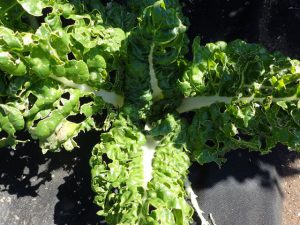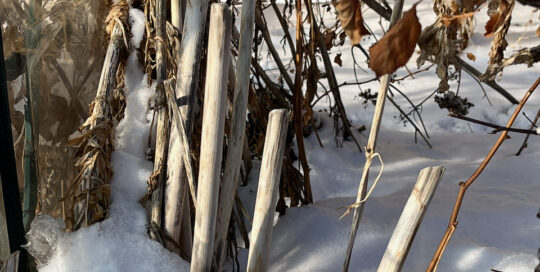Using Bt to battle caterpillars
Views: 1159

Something is eating my Swiss chard. I can’t quite put my finger on what it might be. But, I suspect one of the multitude of caterpillars that are prevalent this time of the season. My go-to remedy for most pest issues in the garden is diatomaceous earth. However, since we are watering more frequently due to the hot, dry conditions, it wouldn’t stay on the plant long enough to do much good. Instead I opted for a Bt product, and it’s doing the trick.
Bt
Bt (Bacillus thuringiensis) is a naturally occurring bacteria (and there are many types) commonly found in garden soil, but when ingested by certain insects, particularly caterpillars, the toxins bind receptors within the guts of the caterpillars disrupting the digestive system and ultimately causing them to die. While this probably isn’t a pleasant means of elimination, it does work well and it is an organic option. Particularly interesting to me is that Bt works on insects because they have an alkaline environment within their digestive system, yet since birds and other animals have an acidic environment, the Bt doesn’t acting the same way. Even though the bacteria proliferates within the gut of the caterpillar, you would think it’s a hotbed of bacterial toxins, but if a bird or other animal eats that caterpillar it wouldn’t harm it because of the acidic environment within their own digestive tract. This is also why it’s possible for us to eat the produce shortly after spraying the plants.
Even so, it is important to use Bt properly. If your problem are slugs, Bt is probably not going to take care of the issue. If you think it’s a caterpillar of some sort then it should work just fine. Also, because Bt is a natural product and is not is systemic pesticide, you’ll need to be apply it more frequently than you would if you use synthetic pesticides. If it rains or you water, reapply it every few days.
Also, it doesn’t outright kill the insect, which alarms some people. If you spray the caterpillar directly with the Bt, you’re not going to watch it die. It needs to take a few bites of the leave before it affects the gut system. Rest assured, it is still working, though. A few bites and they are toast!
Applying Bt
When you’re applying Bt, do so in the morning and be sure to thoroughly spray both sides of the leaves. It does breakdown in the sunshine, so some experts recommend a late afternoon application, particularly at the beginning of the process, if it bright and sunny. (This is also why I have to mix up a new batch. I accidentally left my bottle in the sunshine the other day because I was in a hurry.) Due of the interaction with the sun, Bt does not persist on crops, nor does it build up in the soil or on the plants.
Although I’m a big fan of diatomaceous earth for many of our pest issues, the chard was something best handled by a more specific product targeting the offending species. In this case, Bt was the remedy we needed.
Meet Amy Grisak
Amy is a freelance author and photographer in Great Falls, MT who specializes in gardening, foods, and sustainable agriculture. She provides information on every kind…
Amy's Recent Posts

This Little Piggy is a Problem: Dealing with Feral Hogs








